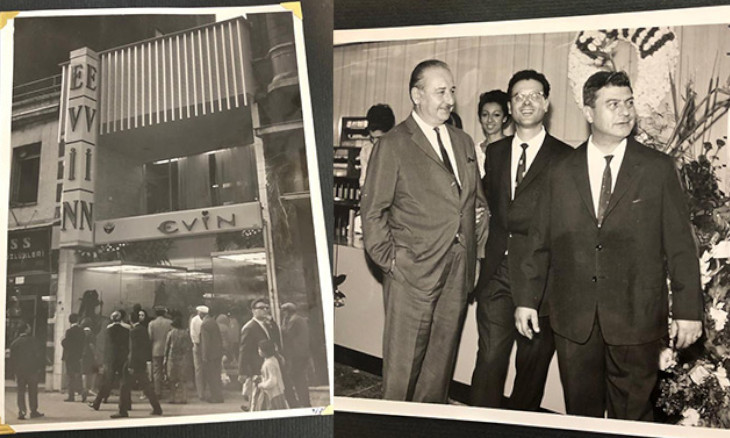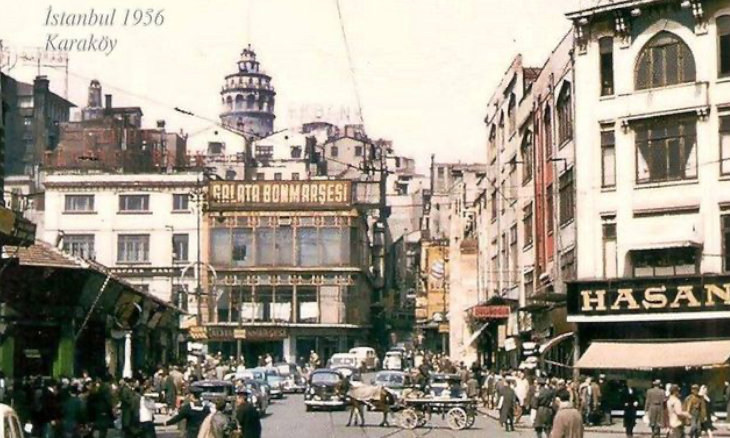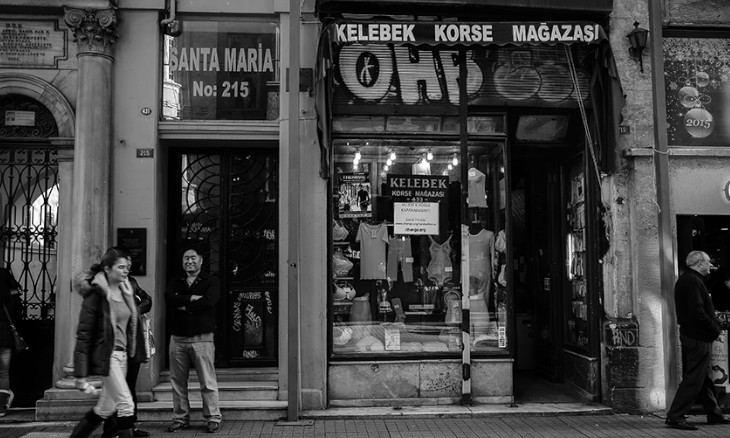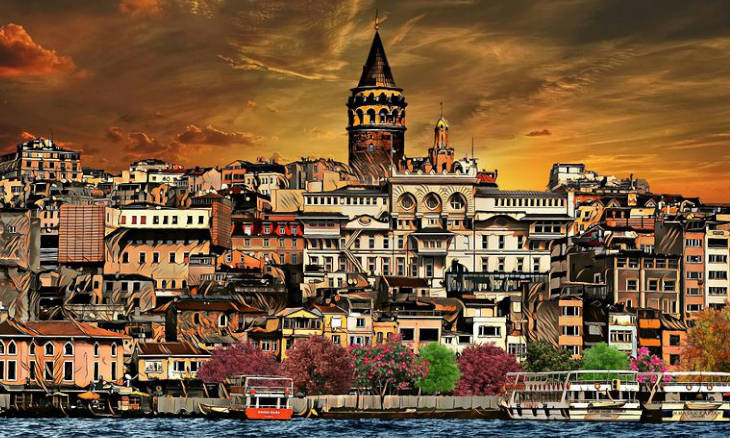Beyoğlu’s Jewish landmarks in fashion II
Mois Gabay writes: In my childhood years, I remember wandering in the streets of Beyoğlu alongside my father. Pera was living its last days. At the end of the street near the French Consulate, lay “Tailor Ragıp.” Mr. Ragıp was famous for making trousers that would fit you perfectly. Tailor Blum had trained him.
Mois Gabay
 Beyoğlu’s Jewish landmarks in fashion
Beyoğlu’s Jewish landmarks in fashionThis is the last part of the series focusing on the fashion world of the Jewish community in Pera and Galata. As we weren’t able to cover such brands as Rekor-Dekor or the Galata Bonmarşesi, we hope that a book gets written that would include all of them. That is what they deserve. In the meantime, let us continue our stroll through the Beyoğlu of a bygone era.
Lion Store (Lion Mağazası)
The Austrian Ashkenazi Heilper family owned the Lion Store. At one corner of the Lion Store lay the “Au Lion d’Or” store that sold shoes and, later, hosiery. In 1935, Hulki Ekler wrote a story entitled “The tea and dance party of the Lion Store” for a women’s magazine. “The haute couture tailors of Istanbul and the fashion creators Cemal, Fegara, Olivye, Calibe and Iren Fayn as well as the hatters Madame Emilia, Zoe, the shoemaker Paçiakis and the underwear shop Eskinazi all participated in the party with their beautiful models,” Ekler wrote. The Lion Store was also mentioned in Rıfat Bali’s “Portraits From A Bygone İstanbul” and Giovanni Scognamillo’s “The Beyoğlu Memoirs of a Levantine.”
An obituary published by the daily newspaper Cumhuriyet in 1940 stated that “Mr. David Bornstein, who had been the director of the Beyoğlu Baker Stores for years, died of the disease he was suffering from on March 23, 1940.” The Heilperns were amongst the mourning families. College students bought grey pants and dark blue, metal-buttoned jackets from the store. It was chosen as the best shop window in a competition organized that was organized in the 1930s.
The Eskinazi’s Maison de Blanc Store
One of my oral history sources was Moris Behar from Hasköy. He told me about the Maison de Blanc store which was owned by the Eskinazi family and was located right next to the Lazzaro Franco Department Store. “Back then, it was the leading firm importing women’s lingering from Europe,” he said. Behar’s family company “Bahar Ticaret” operated on Talimhane Feridiye since 1952. They sold underwear for years. When I asked witnesses of that time about the Eskinazi store, they all said the store “would embroider linen for dowry.”
Hatmaker Pepo
On Galip Dede Street there was once a hatter who sold hand-made hats for men. He’d also repair them. “Pepo” as he was known, was able to keep his store until recently. Rabbi Rav Ishak Haleva, the Chief Rabbi of the Turkish Jews, told me he knew “Pepo” very well: “He lived at the Şişhane bus stop. We played marbles on the street when we were kids. My uncle tutored his son in mathematics. People would bring their fedora hats to Pepo and he would shape them, moist them and repair them with steam.
In his book “İstanbul Kazan, Ben Kepçe,” author Sermet Muhtar Alus refers to the upper side of Yüksek Kaldırım as the “land of hatters.” Pepo’s workshop was famous for hats he had made in the 1940s. In those days, it was frown upon to go out without a hat.
With time, people ceased to wear hats and as a result, hat shops closed down one after the other. Osman İbil, an apprentice of Pepo, opened his own shop later on. In an interview with Cumhuriyet in 2003, İbil said of Pepo that “in the workshop he established in 1937, Jewish descendant Pepo Muraben introduced hat making to Turkey. He was an artist more than anything else. With their perfect shapes and molds, he would export his hats to Europe. After he passed away, several hatters used his name to sell their own hats. The real Pepo died 25 years ago. Despite this, his hats are still referred to and remembered. To this day, some people enter our store and ask whether this was Pepo’s place.”

A living legend: İliya Gülerşen’s clothes shop
For those who cared about their clothes back in the day, the go-to place in Beyoğlu was İliya Roditi Gülerşen’s shop. Sporting white hair and a chic suit, Gülerşen would always greet you like you were a Hollywood actor. His guests would get their picture taken with this “Istanbul gentleman” and buy presents for their family members from his fabulous store.
Gülerşen’s shop was opened in 1958 and from the onset, it would sell pure silk, pure lamb wool, cashmere and classic, British-style luxury clothes. If you were to exit Nevizade Street from the back and walk towards Beyoğlu, you’d come across a modern and carefully restored two-story building. A sign still reads “İliya Gülerşen, Clothier, 1958.” This is Gülerşen’s sanctuary, once Istanbul’s most famous clothes vendor.
İliya Gülerşen told me his story as follows: My family came from Spain years ago. I was born in Şişhane in 1932 as the fourth child of a seven-child family. My father Ovadia would sell fish at the Beyoğlu fish market. I started working after elementary school. I was an apprentice at a bookstore, a print shop and an upholsterer. In my free time, I’d go to my father’s fish stand. My father was a fish seller but even whilst working at his stand, he’d wear a jacket and a tie. He wouldn’t wear an apron, as it would hide his clothes. His customers were aristocrats, rich people and the Istanbul-based diplomats of foreign countries. He wanted me to wear a jacket as well. One day, while I was helping my father, one of our customers had already observed me and told my father “Give me that child. I will train him.” My father agreed at once. That is how the first days of my 62-year long journey with clothes and tailors began.”
One of the famous Acıman traders had asked to train İliya Gülerşen. He worked at their shop on Avrupa Passage for 10 years. After having completed his compulsory military service, he opened his own business in the Solakzade Street of Beyoğlu in 1958. He sold the best brand of fabric available in those days, the Altınyıldız and all other tailor equipment. “My principle was to sell quality goods only,” he said. İliya Gülerşen remains at the same venue, offering special clothes to those seeking quality.
From Şen Şapka to Vakko
One can read the late Vitali Hakko’s success story in his book “My life Vakko.” Vakko told me his story personally: “I was born in Yedikule. When I was 9, we moved to Kuledibi. For any child who lived there, Beyoğlu was the only place to go. We saw our first movie there, at the Elhamra cinema. We watched the first sound cinema there too. It was a film with Marie Bell and Maurice Chevalier… When I first owned a business, our factory was located in Kurtuluş, our sales shop was in Yenicami. But when I commuted to work, I’d always pass by Beyoğlu. I did that to learn new things, to see some well-dressed people. Our passion for Beyoğlu started in those years. It continues to this day. When I wanted to start a ready-made clothing business 25 years ago, I thought I could only make it in Beyoğlu. No other place ever occurred to me. I earned my living from Beyoğlu for years.” Today, Vakko is a small shop in a mall in Beyoğlu. Yet the Vakko legend endures throughout the world.

Kelebek Corset
Another 80-year legend is İliya Avramoğlu’s Kelebek Korse (Kelebek Corset). That shop closed down in 2015 following a rent law amendment that was adopted in 2014. Following that law, other symbols of the city had to leave their venues, such as Emek Cinema, Robinson Crusoe Bookstore, Mayer, Zahaviyedis, İnci Cinema in Harbiye or Kaymakçı Pando in Beşiktaş. Kelebek Korse relocated in Kurtuluş though they did not survive for long.
Day tailors
In Rıfat Bali’s book “A Life Style of the Past: Jewish Neighborhoods,” Mr. İzak Baron explained daily life and clothing traditions:
“Back then, when ready-made clothing was not widespread, you’d remember those tailors that would visit individual homes before important events or during seasonal changes. They were called “kuzendera.” When matchmakers made young people meet, the “entrevista” events were held when they were introduced to each other for the purpose of marriage. Then you’d watch the clumsiness of the families from doorsteps and make fun of them quietly. During dowry preparation days, they would go to designers on Bankalar Street. These designs would then be skillfully printed on clothes. On the weekends, while going out to “Pera,” residents would dress up. Those who had the money and were too lazy to walk would take the “dolmuş” from the front of the Turkish Airlines office and go to Galatasaray or Taksim. Those who walk from Yüksek Kaldırım to Tünel would watch the attractive philately shops – that may lead them to become stamp collectors once past their childhood years. From Tünel Square onwards, the department stores offer fashionable clothes and shoes. Popular stores were Mayer, Lion and Lazarro Franko.”
Mr. İzak added that housewives would host these daily tailors at home. They would prepare special food for them and close family members were invited to assist the tailor. He also explained that while the Beyoğlu ready-made cloth stores were Jewish, not all Jews who lived in the area could afford to buy clothes from them. It was a luxury for them. They would go and buy clothes from Eminönü-Tahtakale. For men, it was a tradition to have Jewish tailors working in Beyoğlu or the Tahtakale commercial buildings make them “sur commande” suits.
In my childhood years, I remember – as if it were yesterday - wandering in the streets of Beyoğlu alongside my father. Pera was living its last days. At the end of the street near the French Consulate, lay “Tailor Ragıp.” Mr. Ragıp was famous for making trousers that would fit you perfectly. Tailor Blum had trained him. Like everyone else, I’d wear trousers he made during all the difficult days of my life, like the beginning of school, my graduation ceremony or any other special occasion.
While fabrics for special days would be bought from İliya Gülerşen, fabrics for daily use would come from the Sümer Bank store in Eminönü. A short while before he died, my late father invited Tailor Ragıp home and ordered several pair trousers from him. After his death, my mother distributed those trousers to whoever needed them.
If we consider Beyoğlu nowadays, those tailors and stores are scarcely remembered. Beyoğlu is gradually turning into an ordinary, monotype street with stores that look identical to each other. Those brands that marked history are nothing more than memories nowadays. Before the old Istanbul is lost altogether, let us hope we’ll make peace with Beyoğlu.
Contributors for their valuable information and documents: Chief Rabbi of the Turkish Jews, Rabbi Rav Ishak Haleva, Verjel İşman, Leon Esim, Yüksekkaldırım Ashkenazi Jewish Synagogue Foundation and İzel Rozental, Kültür Bilincini Geliştirme Foundation Coordinator Ozan Torun, İzak Baron, 500. Yıl Foundation Turkish Jews Museum Executive Board, Silviyo Ovadya, Metin Delevi, Moris Levi, Dani Altaras, Cako Taragano, Moris Behar, Edi Behar, Sami Behar.
 Good from far, far from good: The story of Beyoğlu
Good from far, far from good: The story of Beyoğlu
